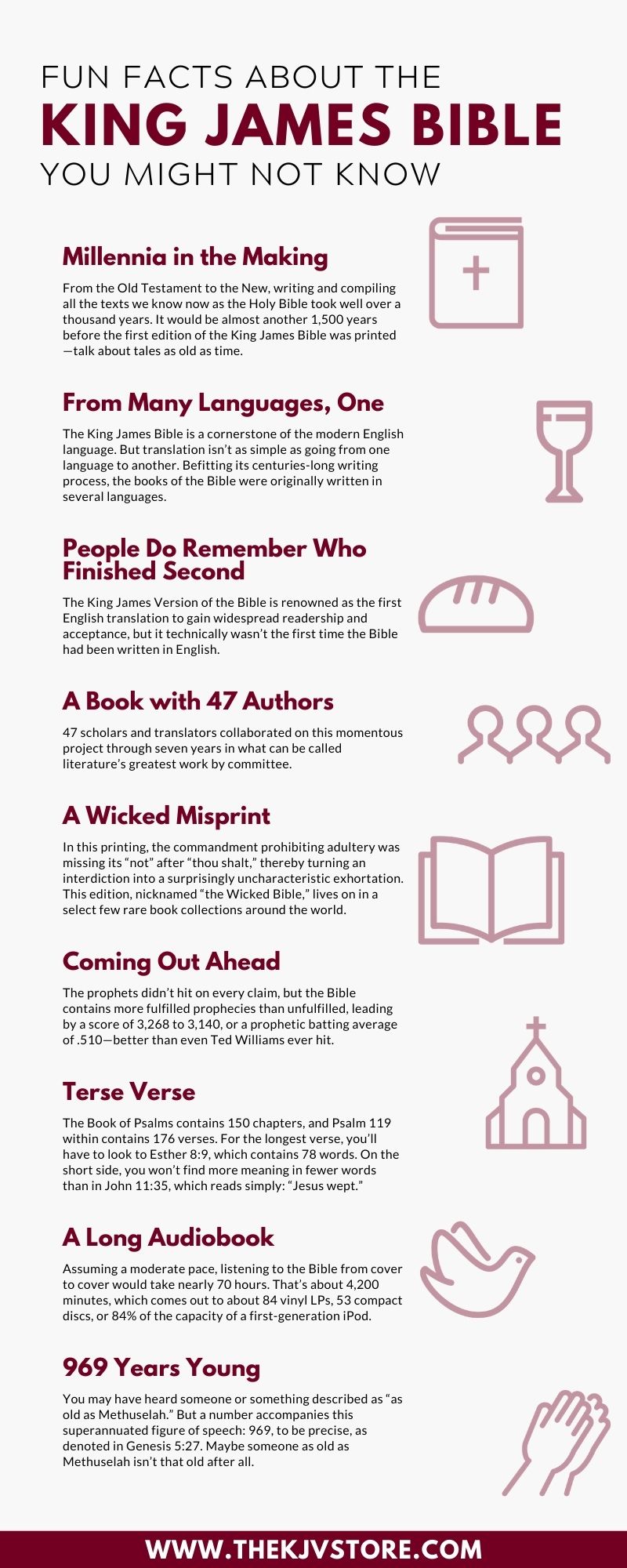Fun Facts About the King James Bible You Might Not Know

Most people are eminently familiar with the cultural and theological significance of the King James Version of the Holy Bible, one of the building blocks of Christianity and of the English language as we know them today. However, you may not know about some of the details in its pages, nor about some of the accidents and disagreements that are part of its rich history. From a look at the numbers—and not just the Book of Numbers—to a disastrous omission in one unfortunate print, there’s a lot of interesting trivia inside and outside of this tome’s pages. Here are a few fun facts about the King James Bible you might not know, from the history of the book’s publication to some of the figures and features within it.
Millennia in the Making
From the Old Testament to the New, writing and compiling all the texts we know now as the Holy Bible took well over a thousand years. The first five books of the Old Testament, known in Judaism as the Torah, were not written down until the 8th century BC at the earliest, but some Biblical scholars believe the stories predate their written records by another 600 years. On the other end of the spectrum, the Book of Revelation was thought to have been completed in 96 AD, bringing the length of the Bible’s composition to roughly 1,500 years. It would be almost another 1,500 years before the first edition of the King James Bible was printed—talk about tales as old as time.
From Many Languages, One
The King James Bible is a cornerstone of the modern English language. But translation isn’t as simple as going from one language to another. Befitting its centuries-long writing process, the books of the Bible were originally written in several languages. The books of the Old Testament were written in Hebrew and Aramaic—a Semitic language closely related to Hebrew and Arabic—while the New Testament was written in Greek—though a version of Greek that was considerably different from the version spoken today. The books of the Apocrypha were written in Greek and Latin.
From these source materials, a committee of translators was able to unify these texts in the common vernacular of the English people, making the Scripture more accessible than it had ever been.
People Do Remember Who Finished Second
The King James Version of the Bible is renowned as the first English translation to gain widespread readership and acceptance, but it technically wasn’t the first time the Bible had been written in English. William Tyndale translated the New Testament from Greek to Early Modern English in 1526, and full translations including the Old Testament would follow. The Geneva Bible of 1560 was the Bible of choice among England’s Puritans, who would go on to settle the New World. However, some of the Calvinist interpretations and annotations, with their insufficient deference to royalty, were highly objectionable to King James, which drove him to authorize a new translation. These Bibles have fallen by the wayside, but the KJV has endured.
A Book with 47 Authors
How many group projects have you worked on where it felt like one person did all the work? The writing of the King James Bible was one of scholarship’s biggest group projects, and suffice it to say that no one person did the whole job the night before it was due. 47 scholars and translators collaborated on this momentous project through seven years in what can be called literature’s greatest work by committee.
A Wicked Misprint
One word can change the entire meaning of a sentence. Unfortunately for one set of printers of the King James Version, that one word lay in one of the Ten Commandments, the set of laws foundational to the Old Testament. In this printing, the commandment prohibiting adultery was missing its “not” after “thou shalt,” thereby turning an interdiction into a surprisingly uncharacteristic exhortation. This typographical error was not a gross liberalization of Mosaic law, much to the chagrin of 17th-century England’s adulterers, and the printers were fined for their mistake. This edition, nicknamed “the Wicked Bible,” lives on in a select few rare book collections around the world.
Coming Out Ahead
Much of the Bible is devoted to prophecy. The prophets didn’t hit on every claim, but the Bible contains more fulfilled prophecies than unfulfilled, leading by a score of 3,268 to 3,140, or a prophetic batting average of .510—better than even Ted Williams ever hit.
Terse Verse
Of the many books, chapters, and verses within the King James Bible, the length of each is highly variable. The Book of Psalms contains 150 chapters, and Psalm 119 within contains 176 verses. For the longest verse, you’ll have to look to Esther 8:9, which contains 78 words. On the short side, you won’t find more meaning in fewer words than in John 11:35, which reads simply: “Jesus wept.”
A Long Audiobook
If you want to make your commute go by faster, you may choose to listen to a reading of the King James Version. Assuming a moderate pace, listening to the Bible from cover to cover would take nearly 70 hours. That’s about 4,200 minutes, which comes out to about 84 vinyl LPs, 53 compact discs, or 84% of the capacity of a first-generation iPod.
969 Years Young
You may have heard someone or something described as “as old as Methuselah.” That may even be older than the hills. But a number accompanies this superannuated figure of speech: 969, to be precise, as denoted in Genesis 5:27. Maybe someone as old as Methuselah isn’t that old after all.
The KJV Store is your destination for fine, leather-bound editions of the King James Bible—no Wicked Bible editions here—with the King James Bible for sale to read almost as it was first written in 1611. As you read your new edition of this old classic, keep an eye peeled for some of the fun facts about the King James Bible you might not know throughout the chapters and verses, short and long.

